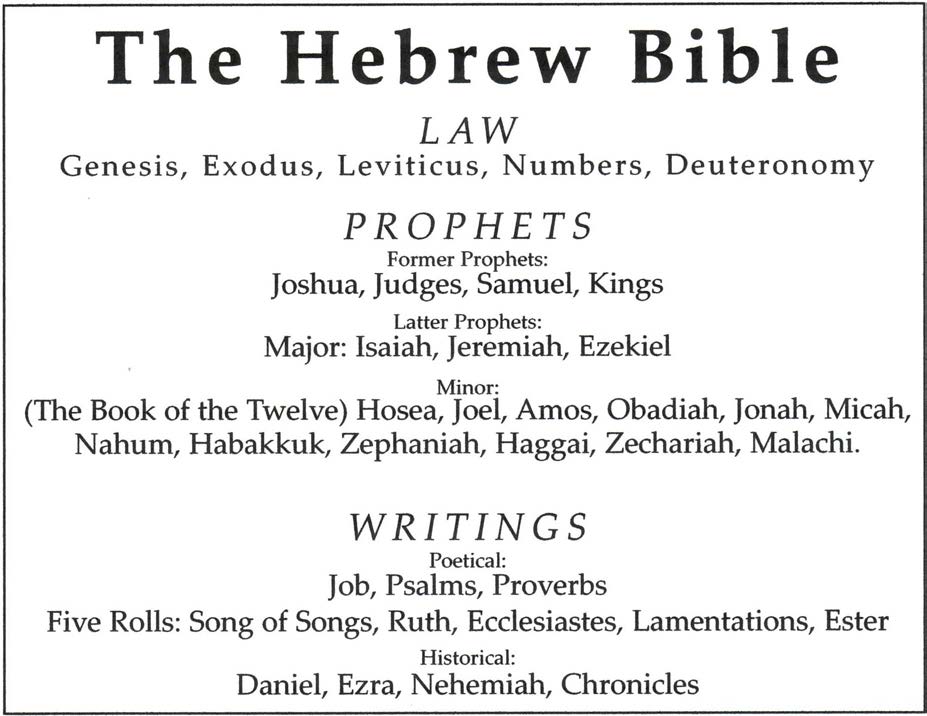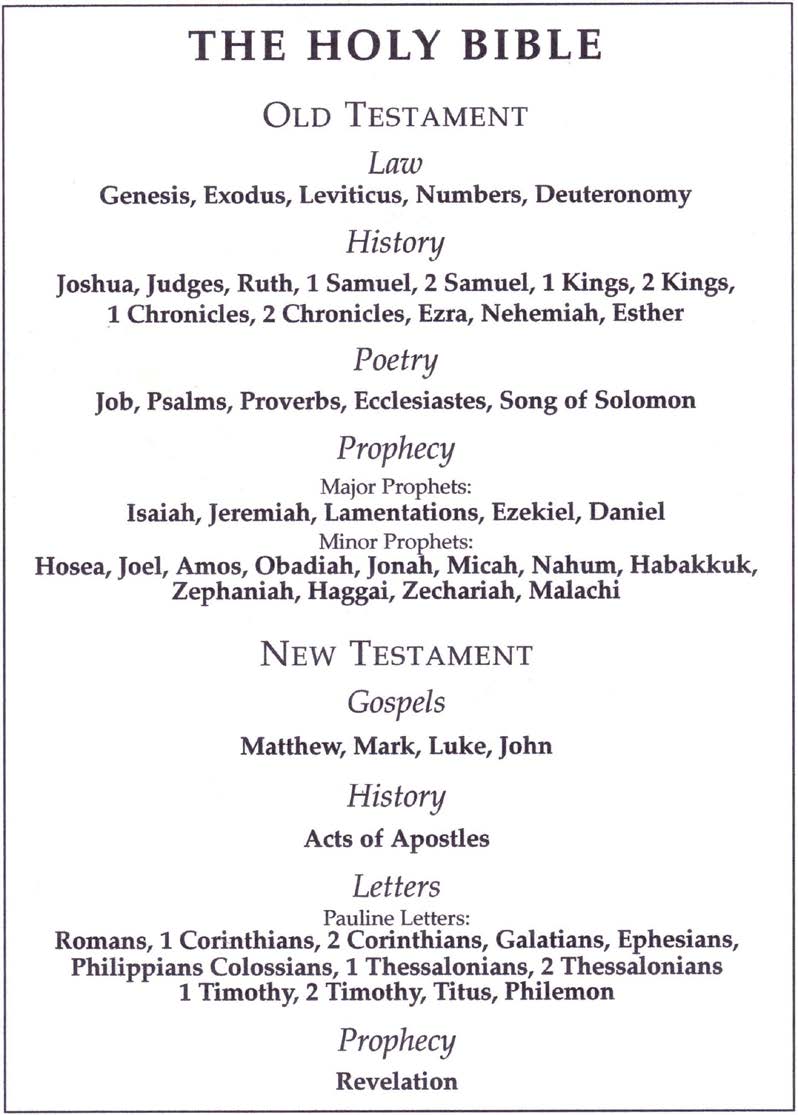
God's Word
CONTENT

God's Word
CONTENT
In previous lessons we have studied the source, growth, and completion of the Bible. These studies led us to considerations about revelation, inspiration, providence, process, language, and canon as they related to the formation of the Bible. These foundational probes opened up vistas that enhanced our knowledge of, and appreciation for, the sacred writings. Therefore, we have an advantage as we turn to an overview of the contents of the Bible.
We already know the Bible was not dropped on our doorstep like the daily newspaper. It did not flash out of the sky like a bolt of lightning. It did not mysteriously rise like early morning wisps of fog from the surface of some plaid, cosmic lake. It is not a collection of dreams or a repository of magical tricks. No. The Bible is an historical saga. It is real, practical, and genuine. Although rooted and grounded in the God of the universe, the Bible comes to us as Sacred Scripture from the pen of God’s men who received His revelation and were inspired by His Holy Spirit.
The Bible not only speaks to us, but of us. We not only learn of God in its pages, but we also find ourselves there. An open-hearted study of God’s Word results in a changed heart. “For the word of God is living and active and sharper than any two-edged sword, and piercing as far as the division of soul and spirit, of both joints and marrow, and able to judge the thoughts and intentions of the heart” (Hebrews 4:12).
Therefore, we turn to an examination of the contents of the Bible, not only because they are historical, but because they address us personally.
When we consider the Bible and its contents, there are certain characteristics and terminologies to which we need to be alerted. The word “Bible” is a case in point. It is an English word. Where did it come from? It came from the Greek word meaning “book” (Biblion = “scroll” or “book.” Its plural biblia [books]. The Greek plural was used by Latin writers as singular in meaning. From Latin it came into English as “Bible”).
Therefore, when we use the word “Bible” to refer to the Holy Scriptures, which were not canonized until about the 4th century A.D., we are employing an anachronism (“a person or a thing that is chronologically out of place”). This is not a matter of idle trivia. It is merely a reminder that when we focus on the content of the Bible, we are looking at a body of literature that had taken its present shape a long time before it was called, in English, “the Bible.”
After the Scriptures were canonized in the 4th century A.D., Jerome (a linguyistic scholar who lived in the 4th and 5th centuries A.D., ca 374-410) called them “the divine library” (Bibliotheca Divina). The useful arrangement of the text into verses, which we appreciate so much as a study help, was absent from the Bible at that early date. The versification of the Hebrew Scriptures that we are familiar with started as early as 700 A.D., but was not standardized until about 900 A.D. by the family of Ben Asher, Masoretic scholars of the first order. Verses appeared in the New by the family of Ben Asher, Masoretic scholars of the first order. Verses appeared in the New Testament in the middle of the 16th century A.D. However, chapter divisions of both the Old Testament and the New Testament were already present by the middle of the 13th century A.D., and are attributed by some scholars to Cardinal Hugh of St. Cher in 1244. However, others believe Stephen Langton, Archbishop of Canterbury, who died in 1227 A.D., was responsible for the chapter divisions. Verses “first appeared in the New Testament in Robert Stephens’ edition of the Greek Testament in 1551. Henry Stephens, Robert’s son, reports that they were devised by his father during a journey on horseback from Paris to Lyons.”
The Geneva Bible of 1560 A.D. was the first complete English Bible to contain chapters and verses as we have them today. Of course, the chapters and verses of the Bible have never been considered a part of the sacred text, but merely help in the study of God’s Word.
We will note some other features in this vein as we later look at translation. At this point, however, we turn to the books of the Hebrew Bible (Old Testament) as they were arranged when all of them had been completed. This early grouping of the books of the Hebrew Scriptures is that to which Jesus referred when He addressed His followers, saying, “These are My words which I spoke to you while I was still with you, that all things which are written about Me in the Law of Moses and the Prophets and the Psalms must be fulfilled” (Luke 24:44).
It is important to remember that we are considering the Old Testament (Hebrew Bible) which had been completed by the time of Christ (Of course, the Jews did not consider their Bible “old.” In fact, it did not become “old” until after the death of Christ, the Messiah. (Read Hebrews, chapter 8 and 9). Although there were some minor differences in the arrangement of a few books within the three major groups by various Jewish scholars and writers from time to time, the contents were never altered.
The tripartite arrangement of the Hebrew Scriptures of which Jesus was aware was a result of the Jewish scholars’ work in the regions where the Hebrew Bible was edited and protected, Palestine and Babylonia. We stress again, the textual content of the ancient canonized Hebrew Bible is the same as we find today in the English Old Testament (Titles of some books were changed in the great Septuagint [LXX]. The Septuagint [LXX = Roman numeral 70 was the title assigned to the translation of the Hebrew Scriptures into Greek). That content, and the English titles with which we are familiar, are given below in the three-fold grouping.

Note: The total number of books in the ancient Hebrew Bible was twenty-four. However, when Samuel, Kings, Ezra-Nehemiah, and Chronicles are considered as two books each, and The Book of the Twelve is considered as twelve books, the total is thirty-nine, the number of books in our English Bibles today. Obviously, the difference is a difference in arrangement or classification, not content (The Hebrew Bible is sometimes called Tanak. This is an acronym for three fold division of Law [Torah], Prophets [Nebiyium], and Writings [Ketubiym]).
We have already studied the formation of the New Testament canon. Before the canonization was complete in about mid-4th century A.D., various books had been circulated together. For examples: The writings of Luke were understandably kept together, since Luke wrote to Theophilus and spoke of one part of his discourse as a continuation of the other (Luke 1:1-4; Acts 1:1-4).
However, not long after the New Testament was completed, Luke’s first treatise was separated from the second and placed with the other three Gospels. These four Gospels were simply called The Gospel, consisting of Matthew, Mark, Luke, and John. They contained the works and teachings of Jesus (Luke 1:1-4; John 20:30-31; 21:24-25). Luke’s second treatise became Acts of Apostles, which, he explained, followed his first correspondence (Acts 1:1-11).
Another collection of the inspired writings that circulated among the churches at an early date was the letters of Paul. These letters were simply called The Apostle. Just as The Gospel collection prepared the way for the history contained in Acts of Apostles, The Apostle collection (Paul’s writings) fitted well into the historical framework of the expansion of the church related in Acts of Apostles. These three collections, along with other inspired epistles later classified as Catholic (General) Epistles, and the prophetic book of Revelation, completed the New Testament corpus.
After the canon that we investigated earlier was formed, there never has been a successful challenge against it. Changes and arrangement or classification of any book or books of either Old or New Testaments have never altered the contents of either Testament. There never has been a valid addition to or subtraction from the ancient canonized Hebrew Scriptures (Old Testament) or the Greek Scriptures (New Testament).
The complete Bible in our hands today is God’s tour de force. It is one of history’s most convincing examples of God’s over-arching providence. Woe to those who take anything away from this sacred text or add anything to it. Blessed are those who surrender to its teachings. This book came by the revelation of God. It is inspired Scripture penned by Spirit-filled men. In spite of many assaults on its integrity, much ridicule about its relevance and rebellious or ignorant disregard of its message, the Bible still stands as the solid foundation for any enduring civilization. It is the light that leads to the Lamb of God who offers salvation to all, and the standard by which we shall all be measured when we appear before the great judgment bar of God. This “divine library” is before us in English translation as follows:

(Unless noted, Bible translation used is the New American Standard Bible)